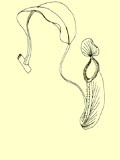

 |
Reef fish diversity in Hong Kong
by Yvonne Sadovy
The rocky reefs and coral communities of Hong Kong hug the coast and islands of eastern and southeastern waters and shelter a surprising diversity of fish species. A recent four-year survey produced over 320 species, a third of which were new records for Hong Kong and one was new to science (see also Cornish, this issue). Moreover, the literature suggests that a further 200 species have been recorded from these habitats. Such diversity exceeds that of the fish fauna of the tropical Caribbean, yet, sadly, just as we come realize what we have, so does it become clear what we are losing.
From interviews with fishers and divers and accounts
in the literature, it is evident that many fishes, once common enough
to be commercially important in local waters, are now uncommon, even rare.
Several larger species of wrasse such as the Black-spot tuskfish (![]() ),
Choerodon schoenleinii, which can reach 1 m in length, was common
in the 1960s but is rarely taken locally today. The famous Humphead wrasse
(
),
Choerodon schoenleinii, which can reach 1 m in length, was common
in the 1960s but is rarely taken locally today. The famous Humphead wrasse
(![]() ), Cheilinus
undulatus, although probably never common here, has now all but disappeared
from our shores. Three decades ago, of 8 species of grouper considered
to be locally abundant, most are rare today. Even the Hong Kong, or Red,
grouper (
), Cheilinus
undulatus, although probably never common here, has now all but disappeared
from our shores. Three decades ago, of 8 species of grouper considered
to be locally abundant, most are rare today. Even the Hong Kong, or Red,
grouper (![]() ),
Epinephelus akaara, once caught in ‘considerable quantity…from
Port Shelter and the Nine-pins…’ (Chan, 1968) in the 1960s, is no longer
common, while the Mud grouper (
),
Epinephelus akaara, once caught in ‘considerable quantity…from
Port Shelter and the Nine-pins…’ (Chan, 1968) in the 1960s, is no longer
common, while the Mud grouper (![]() ),
E. bruneus, formerly abundant on trawl grounds, is now one of the
rarest. These losses and declines reflect their vulnerable nature; they
are long-lived, slow-growing and little capable of withstanding the various
pressures exerted by a burgeoning coastal community (Sadovy and Cornish,
2000). Indeed, given that such species are often the first to respond
to over-fishing, they may represent good indicators of the fishery condition
of local reefs.
),
E. bruneus, formerly abundant on trawl grounds, is now one of the
rarest. These losses and declines reflect their vulnerable nature; they
are long-lived, slow-growing and little capable of withstanding the various
pressures exerted by a burgeoning coastal community (Sadovy and Cornish,
2000). Indeed, given that such species are often the first to respond
to over-fishing, they may represent good indicators of the fishery condition
of local reefs.
This diverse fish fauna may now be facing threats of yet another kind; those posed by introductions. As marine resources in SE Asia become scarcer, efforts to ‘improve’ them follow apace. One approach being applied in Taiwan and also proposed for Hong Kong, is known as ‘restocking’ whereby young fish are purchased and released in the hope that they will replenish the fishery. Not only is there little evidence that such releases make any difference to an unmanaged recipient fishery, they often involve imported fishes, thereby introducing species, genotypes or diseases not natural to the release area. Just as excessive extractions or habitat losses can negatively impact fish communities, so can ‘additions’ prove not only economically, but also ecologically, costly.
Approaches to maintaining our rich and beautiful reef fish fauna would be to protect small areas of coastal waters and to prohibit imported marine introductions. Expansion of our marine reserve or park systems and prohibitions of fishing in marine parks would contribute to conserving a small percentage of Hong Kong’s coastal areas. Surely it is inconsistent that, while hunting is not permitted in country parks, fishing is permitted in marine parks? Such protected areas can also improve surrounding fished areas by emigration of fish and movements of eggs and larvae out of the reserve area. Good news from Cape d’Aguilar Marine Reserve is that within a few years of protection, smaller fishes appear to have increased in abundance, while larger, commercial, species show signs of greater numbers and larger sizes; a great attraction for divers! (Porcupine! Cornish N. 21:15). By appreciating and understanding the richness of the fish fauna along local shores, the better we are placed to recognize depletions and prevent losses.
 |
The rare Longhorn cowfish, Lactoria cornuta, is found in shallow water coral communities in Hong Kong. |
Bibliography
Chan W. L. 1968. Marine fishes of Hong Kong.Part 1. Hong Kong Government Press, Hong Kong. 129pp.
Sadovy, Y. and A.S. Cornish. Reef fishes of Hong Kong. Hong Kong University Press. 320pp.
P.1
|
Porcupine! |
 Copyright © 2000 |